The lubberly hernia I sprung lifting the massive cardboard box off my doorstep was 70% covered by Japanese national health insurance. No worries; I’m not in debt. Yet. I half-expected the parts to a WWI land mine for my pains. Can’t say I was disappointed after prying open the cardboard to find the WA7, the first of Woo Audio’s new breed of neutered steampunk. Sat next to a WA6, it reminds one of a 1980‘s ‘Volvo’: boxy, but good. Jack calls it ‘fireflies’ and it’s pretty awesome.
Specifications
Single-ended, class-A, transformers output
Linear external high-performance power supply (remote-controlled power switching)
Two 6C45 driver/power tubes
C-Media 6631 USB chip
TI PCM5102A 32-bit DAC chip
Headphones impedance : 8-600 Ohms
Input impedance: 100 Kilo-Ohms
Sampling rate: up to 32-Bit, 192kHz
Inputs: 1 Asynchronous USB2.0, 1 RCA
Outputs: 1 1/4" and 1 1/8" headphone outputs, 1 RCA (same connector as the input)
Max output: approx 1 watt @ 32 ohms
Frequency response: 11Hz to 27kHz, +/-0.5dB
Distortion: <0.03%
S/N: 95dB
Power consumption: 25W max
Mains supply: 100-120V, 220-240V, 50/60Hz, user selectable
Finish: Anodized aluminum
DC cord length: 4.25 ft or 1.3 m
Dimension: AMP: 4.8" L x 4.8" W x 5.1" H with glass
PSU: 7" L x 3.5" W x 2.2" H
Weight: AMP - 5.3 lbs / 2.4kg, Glass - 3.3 lbs / 1.5kg
PSU - 2.8 lbs / 1.4kg
Woo Audio WA7 - 999$ USD
ohmage: DAC functionality
Fireflies sports analogue RCA inputs as well as this decade's Ubiq, USB. The latter is plug-and-play simple for OSX and iPads. iPhone and iPod touch users will have to jailbreak their devices to enjoy the WA7. Windows users will have resort to using Woo Audio’s drivers.
The RCA jacks at the back serve dual purposes. When utilising USB input, they double as analogue outs. Otherwise, they are analogue in. Clumsy, yes, but functional.
ohmage: haptics
I’m staking whatever I’ve got left (about 507¥) after a trip to the beer store (and that hernia operation) that Jack Wu knows about Knob-Feel. The WA7’s got a great knob. Camera folk: it’s like using a properly greased Zeiss 35/2 Biogon ZM: rigid and well-damped. Unlike the Japan-made Zeiss, however, there is no play in its revolution. Control freaks will love its long throw. Earphone freaks will appreciate its noiseless operation. Twiddling it with two fingers is best.
Let’s get back to what put me under the knife: weight. With its glass guard in place and valves installed, fireflies tips the scales at almost 4 kilograms. Side by side with CENtrance' DACmini, the WA7 is a fat man in tight shoes. It is smaller but much heavier than Antelope Audio's Zodiac DAC/headphone amp. Unlike either the Zodiak or the DACmini, it won’t flirt around your desk as you complacently attempt to stuff its jack with your headphone bits. Weight, my friends, is as much desktop audio’s bedfellow as it is hernia’s.
Fireflies’ arse bristles with doohickies: power switch, hi/low Z selector, input selector, input panel, and a puckering power inlet. The hose connects to a proper power supply that is practically as big as the WA7. And yes, it is stitch-popping heavy. Ditto the hose, which for the same reason boasts a sturdy screw-in ass-ring that ensures the amp stays coupled to its power source.
ohmage: kitsch
The first litmus test for any piece of desktop audio gear is ‘what the wife thinks’. No amp has ever passed my wife’s litmus. The good news for Woo is that she didn’t exactly turn her nose up at fireflies. She likes polite. She married a Swedish-born Canadian for god’s sake. I eat pizza with a knife and fork, burp into my elbow, double flush. When she saw the WA7‘s clean, 80‘s Volvo-esque lines, she saw polite. She might have seen me for all I know.
Woo Audio don’t beam you with fireflies branding. They’ve kept the WA7 logo small. No gold bling anywhere. Even the top glass hides the glowing valves and the beautifully etched ‘Woo Audio’. This is probably Woo Audio’s most understated design to date. I think it will have many fans, though there are a few out there, who like me, love steampunk. Everyone has their weaknesses.
By the way, WA7 looks and sounds great with the love-it hate-it Fostex TH600.
porridge: build quality and polish
Talent for inducing hernia is one thing; hardware follow-through is something else. The WA7 isn’t by any means, shoddily made. No. Its quirks, however, are several, and poignant. The first is the glass top. It slides around at the smallest earthquake (and not every earthquake around here is small). Even when the ground isn’t quaking, simply typing at the same desk the WA7 is perched on is enough to cause the chassis to rattle.
The culprits are many. The worst is the wiggle room open between the the valves and the glass slab. The fit between metal and glass is poor. Coupled with the sheer weight of the melted sand roof, the resultant wiggle room is enough to break the valves. Woo Audio are now shipping rubber feet with every WA7. Good on them. But I’d rather support the valves with metal rings.
The second issue is less egregious, but belies the WA7‘s 999$ price tag (plus shipping and earthquake insurance). It’s the unanchored, wiggly woggly RCA connection which is reminiscent of a MUCH cheaper amp. Carefy do, carefy do.
The final complaint is even more riddled with holes. It’s WA7’s half-arsed USB plug ‘n play software. The good news is that it works as advertised. But, the USB receiving chip has many functions, including SPDIF input and a multitude of outputs. What shows up in your preferences panel for the WA7 is: Speaker and SPDIF Output. ‘But my computer already has speakers, and SPDIF output’ you say. If you are used to browsing your computer’s audio output devices, simple deduction will get you to the WA7. If not, trial and error is the road you’ll have to take. In its current form, USB plug and play reminds one of the care a knock off vendor puts into their products.
ohmage: sound
Fireflies boasts lower noise levels than Centrance’ DACmini while adding the goodly harmonic bits valves are known for. The long-throw volume pot ensures all but the most sensitive headphones tracking headroom even at low volumes.
ohmage: Noise at a 100% turn of the WA7‘s volume pot is less than the ALO Rx at low volume levels.
Woo Audio is rather an icon among valve headphone aficionados. They make superlative interfaces and chassises. If you want tubey sound, they’ve got an amp for you. Ditto non tubey sound. Ditto all-out power. Fireflies trends towards the latter two, blending clear, far-reaching highs and excellent upper midrange timbre, with a meagre, but healthy dose of harmonic distortion and decent stereo separation.
If there ever was a desktop equivalent to the godly Portatube+, the WA7 would be it. It’s the wonderful, grain-free timbre- no, it’s those violin-loving upper mids that do me in. Upper midrange ring is well controlled, but vestiges remain, adding sweetness to your concertos and jazz ensembles. Comparisons don’t stop there. Both Jaben’s amp and Woo’s exhibit slight signal-warming harmonic decay artefacts. Fireflies’s midrange comes away more a little more active while Jaben’s treble comes away with a bit more sparkle. Overall, the two share rather compatible voicing.
ohmage: WA7’s penchant for mid-high voiced strings makes it one of the best desktop amps for classical and jazz.
Pairing the WA7 with your favourite warm headphone is glorious. On the portable end, Audio Technica’s ESW11LTD is a heavenly match. In a worst-case scenario, the WA7 is able to push over 65dB stereo separation into the likes of Audio Technica’s ESW11LTD while keeping THD and IMD quite low. The results don’t change much when pushing the ES7. Easier to drive headphones such as Sennheiser’s HD600 exhibit less load on the WA7. Even at harsh volumes, headphones like Fostex TH600 remain mostly sizzle free. Of course, easy to drive cans such as the DT880 600Ω are chicken soup and can be driven stably at any turn of the volume pot. One thing you may notice, however, is channel imbalance, especially with sensitive headphones.
porridge: WA7’s volume pot exhibits up to 2dB of channel imbalance at all volume positions.
When comparing output across several different headphones at varying sensitivities and impedances, I rounded out a semi-quick conclusion: WA7 is most at home above 80Ω. Semi-low sensitivity is also favourable. The likes of Heir Audio’s amazing Tzar 350 and 90 earphones still stymie the WA7‘s output. While their impedances fall into the WA7‘s comfort zones, they simply don’t get enough low-voltage current to remain 100% stable. Still, they run much better than stage monitors like Earsonics’ SM2 does.
Ringing in at 25Ω, the Fostex TH600 weighs in at the very bottom of the WA7’s semi-comfort zone. The errors it forces are minor: slight low frequency fall off and rise in IMD. Despite these issues, the couple make a great pair.
porridge: WA7 has a semi-high Ω output. It is best paired with headphones with impedances of 80Ω or more. Low-Ω headphones will force various signal errors.
Like many good hybrid valve/solid state designs, the WA7’s best frequencies are its upper mids and lower trebles. Both boast flavour of their own and ring beautifully. Violin timbre and detail is toast-worthy. You owe it to yourself to check out Bach’s Sonata for Violin #3 with a pair of woodies and this Woo.
While you won’t get record attack/decay speed from the WA7, channel separation and stereo artefacts are low. Combined with the right headphone, headstage can be surprisingly good.
The WA7 is Woo’s most interesting departure from its steampunk roots. Its quadrangle design invites wifal approval. Its plug and play simplicity invites the newbie. Its power invites long time headphone users. Awkward USB driver branding, pliable RCA jacks, and the slippy glass roof describe a Woo Audio that may have rushed production. Which is a shame. WA7 is a great product. It sounds great. It looks good. And it works. But it doesn’t really feel like a 999$ product from an American company - particularly after springing a hernia.
ohmage: 6
porridge: 3








